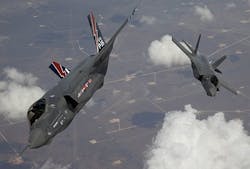Lockheed Martin to build advanced threat radar to help F-35 pilots evade modern anti-aircraft missiles
Officials of the Air Force Life Cycle Management Center at Hill Air Force Base, Utah, announced a $104.6 million 10-year contract Monday to the Lockheed Martin Missiles and Fire Control segment in Grand Prairie, Texas for the Advanced Radar Threat System Variant 2 (ARTS-V2).
The ARTS-V2 is to be a ruggedized mobile system designed to emulate radar-guided surface-to-air missile threats like the Russian-made SA-10, SA-12, and SA-20, which are built to strike at everything from low-flying drones and stealth cruise missiles to high-altitude reconnaissance airplanes and distant sensor platforms.
The SA-10 is designed to shoot down jet fighter aircraft like the F-35 and earlier-model combat jets. It has a range of nearly 50 miles and top speed approaching Mach 6. The SA-12 is for shooting down tactical ballistic missiles, and similar to the U.S. Patriot missile. The SA-20, meanwhile is an advanced development of the SA-12.
Lockheed Martin will build the ARTS-V2 to provide threat-representative radar tracking and reaction such as acquiring, tracking, and engaging several aircraft simultaneously with representative receiver, processor, and electronic counter-countermeasures.
The system will emulate advanced anti-aircraft missile radiated power, threat signals, antenna patterns, operational modes, and threat tactics, and can send real-time radar data to the Digital Integrated Air Defense System (DIADS)-controlled threat environment at the Range Control Center (RCC). ARTS-V2 will provide multi-spectral threat representation.
The ARTS-V2 is part of the overall Advanced Radar Threat System (ARTS) project to develop and field high-fidelity threat phased array radar for live, virtual, constructive aircrew training for anti-access and area-denial environments.
ARTS will provide the advanced capabilities necessary to train aircrews in the employment of F-35 aircraft against foreign fielded live double-digit surface-to-air missile threat systems. The program consists of the strategic long-range ARTS-V1 and the tactical short-range ARTS-V2 systems. The solicitation for the ARTS-V1 system was released in January.
On Monday's contract, Lockheed Martin will build one ARTS-V2 system, and will have options to build as many as 20 additional systems. The company will do the work in Grand Prairie and Austin, Texas; Syracuse and Tallman, N.Y.; Orlando, Fla.; Palmdale, Newark, San Luis Obispo, and Northridge, Calif.; Colorado Springs, Colo.; Batavia, Ohio; Clintonville, Wis.; Huntsville, Ala.; Atlanta; Middletown, R.I.; Virginia Beach, Va.; and Scottsdale, Ariz., and should be finished by June 2027.
For more information contact Lockheed Martin Missiles and Fire Control online at www.lockheedmartin.com/us/mfc.html, or the Air Force Life Cycle Management Center at www.wpafb.af.mil/aflcmc.
Learn more: search the Aerospace & Defense Buyer's Guide for companies, new products, press releases, and videos
